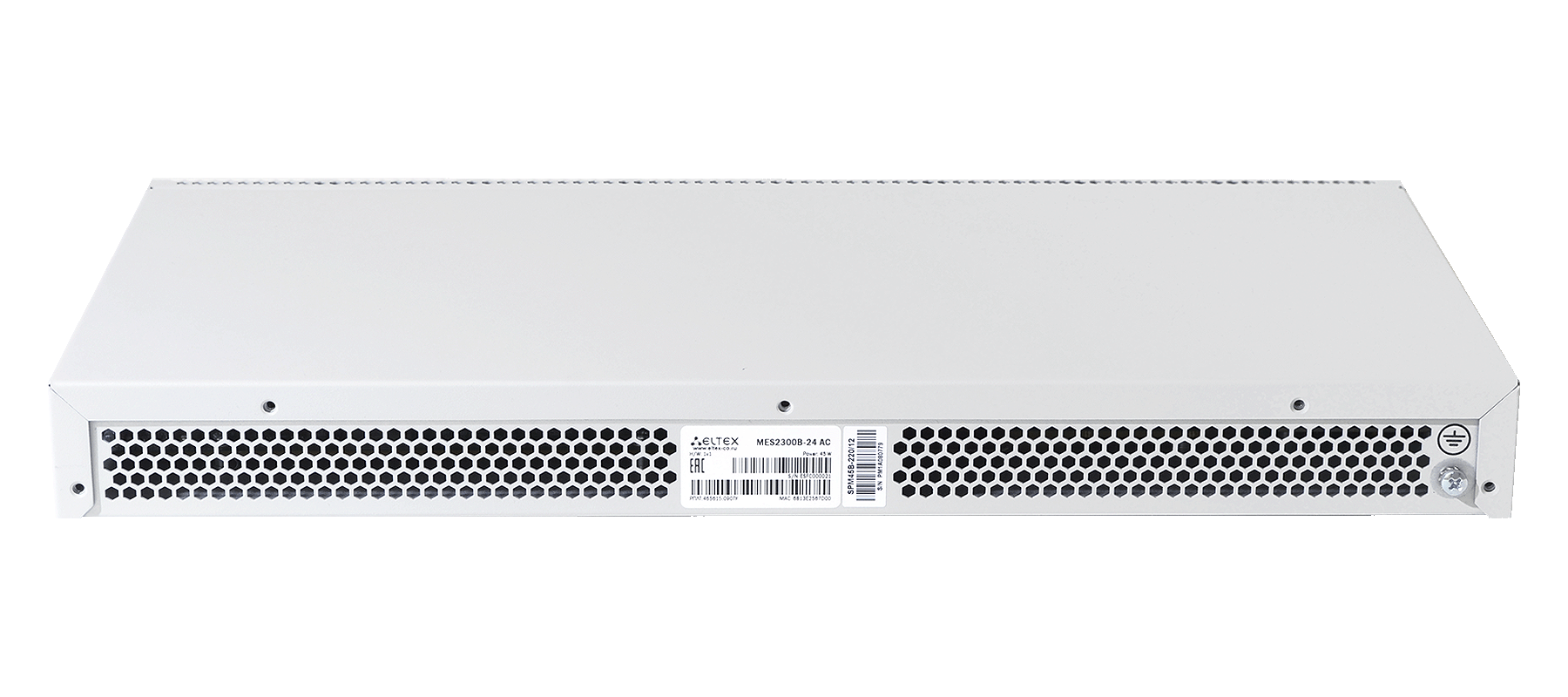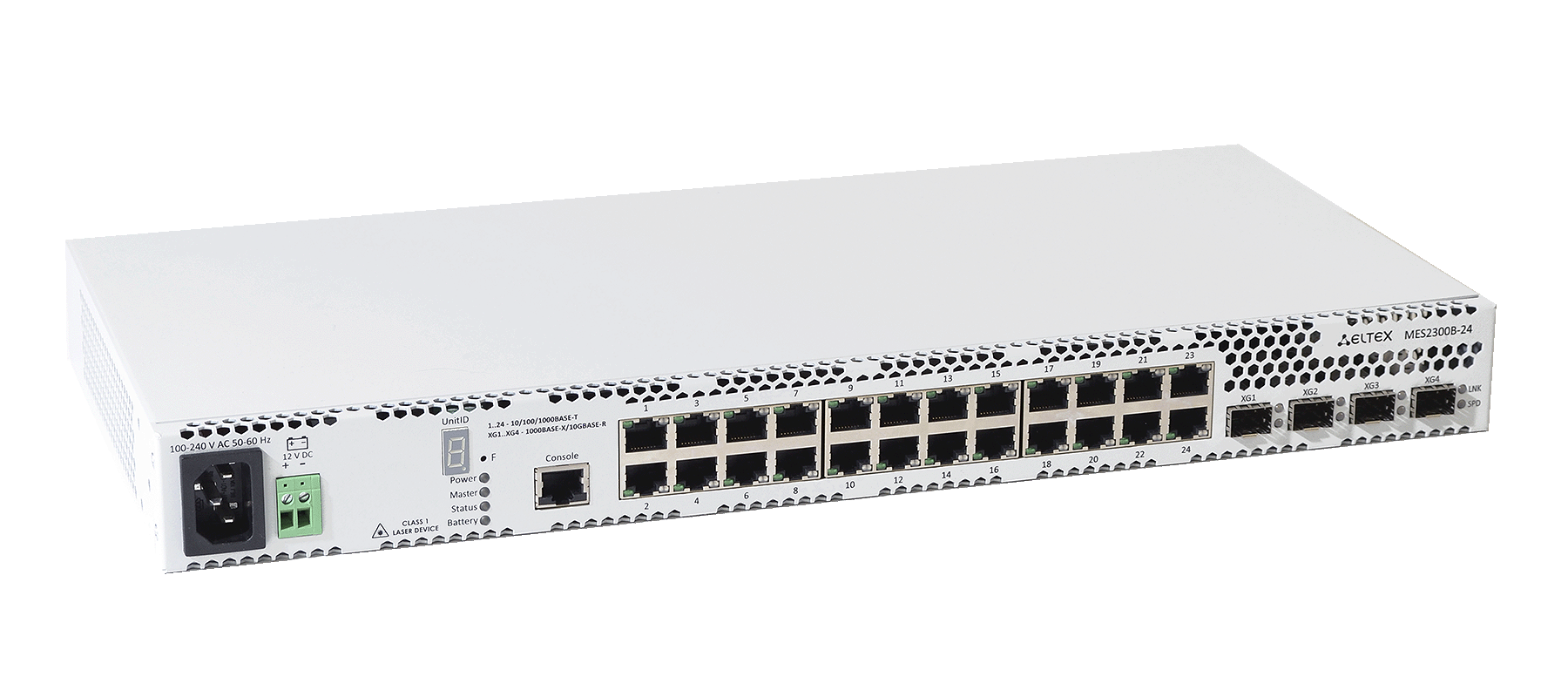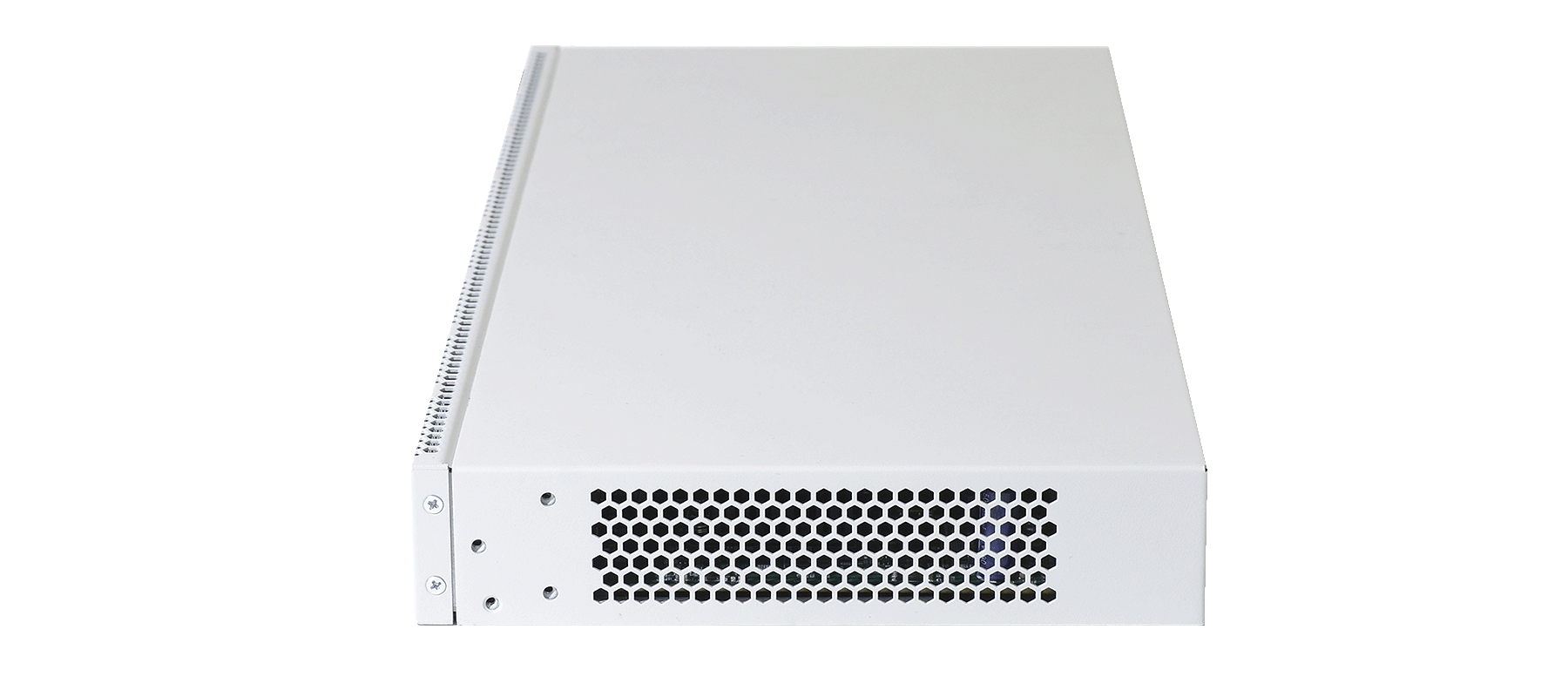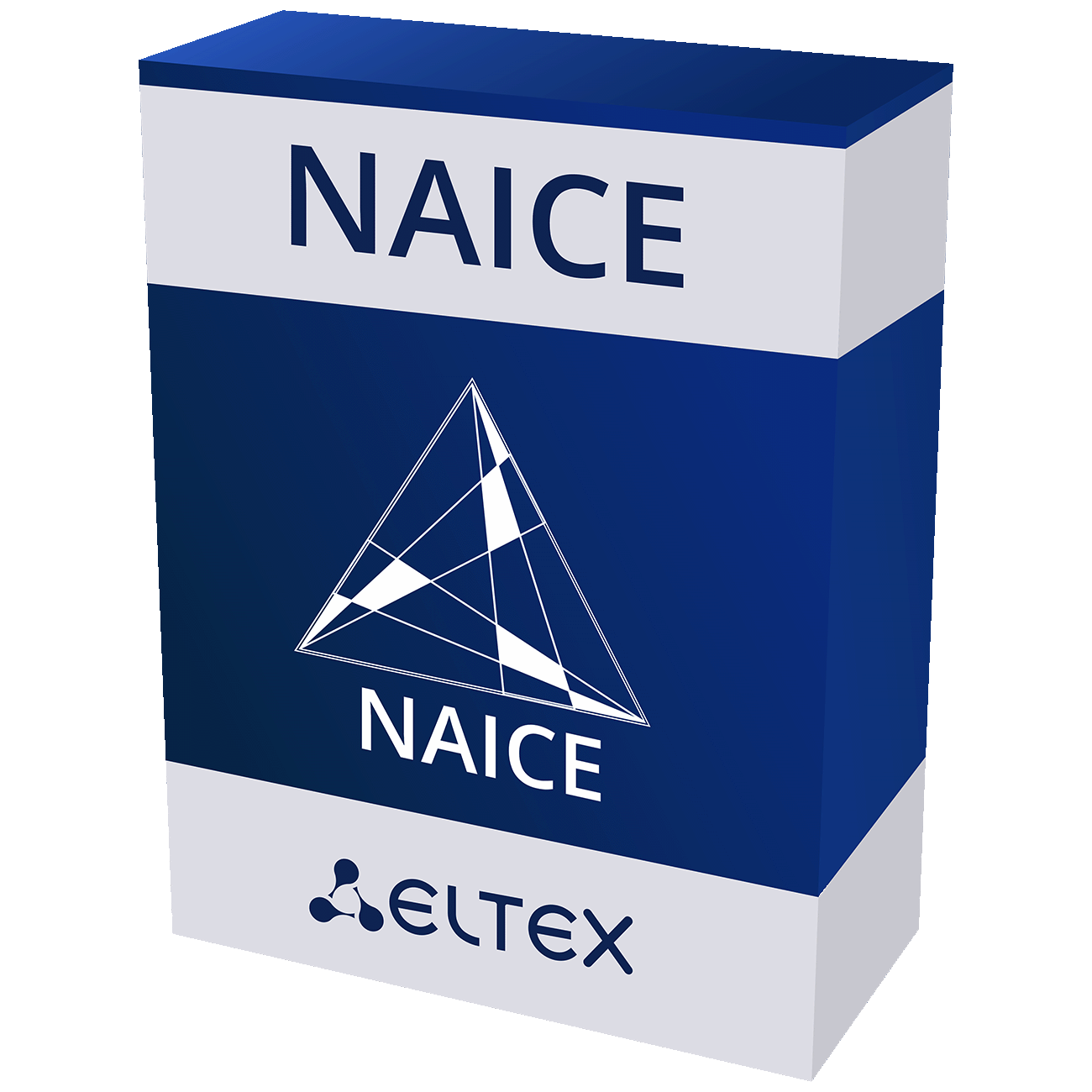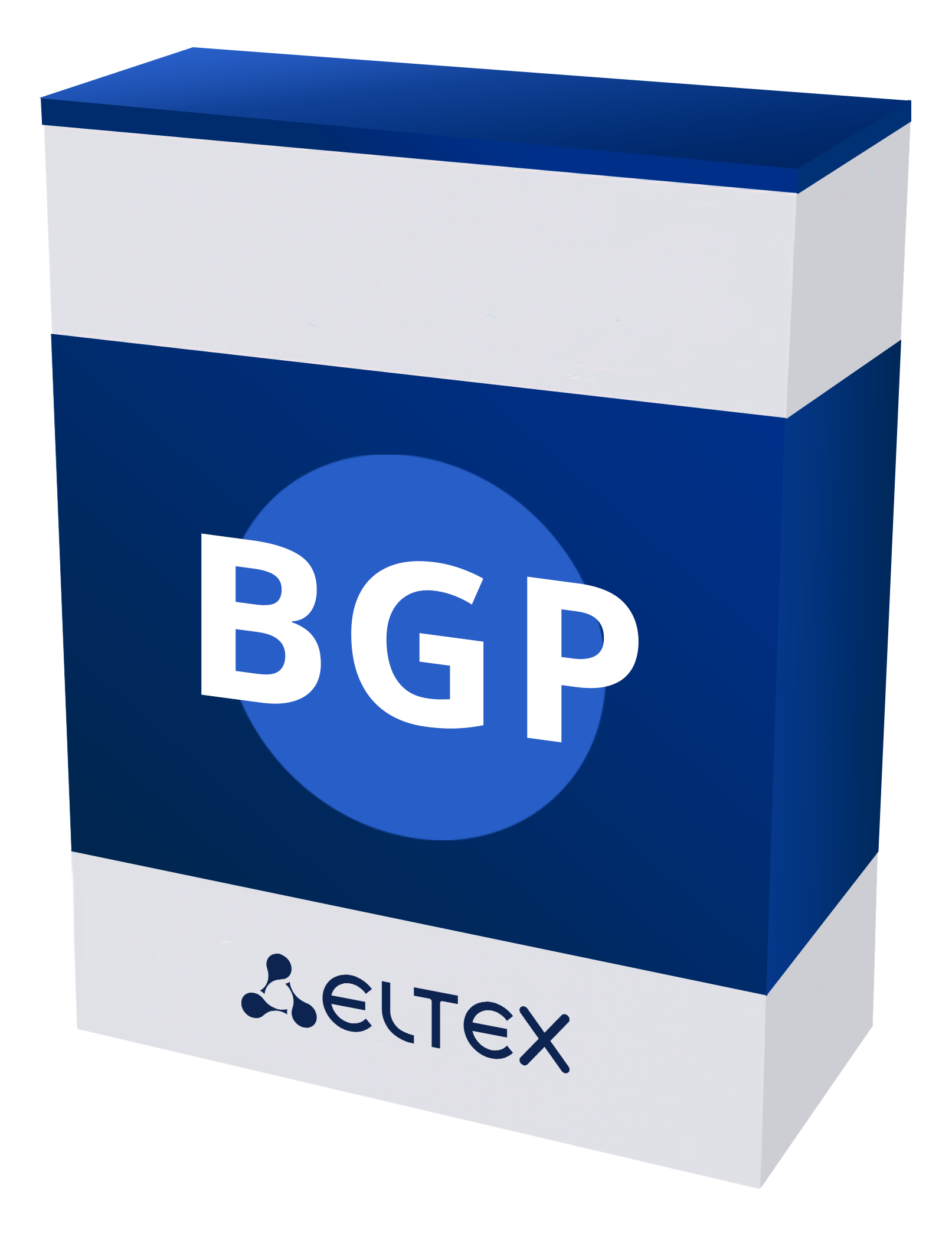Ethernet Access Switch MES2300B-24
- Level:
- L3
- Bandwidth:
- 128 Gbps
- Interfaces:
- 24x1G, 4x10G SFP+
- Power supply:
- AC (Possibility of battery connection)


Description
The new generation of MES access switches connects end users to the network of large enterprises, small and medium-sized businesses and service provider networks using 1G/10G interfaces.
The device ports support both 1 Gbps and 10 Gbps speeds, providing flexibility in use and the ability to gradually upgrade to higher data rates. The non-blocking architecture allows correct processing of packets under maximum loads, while maintaining minimal and predictable delays on all types of traffic.
The switch functionality provides physical stacking, support for VLANs, multicast groups, and advanced security features.
Uninterrupted Power
The MES2300B-24 switches have the ability to connect a rechargeable battery to ensure guaranteed power supply in case of the 220 V primany network failure. The switch is equipped with a power module that allows charging the battery when 220 V is available. The backup power system makes it pos-sible to monitor the state of the primary network and notify of a power type switching.

Specifications
- Level:
- L3
- Bandwidth:
- 12.8 Gbps
- Interfaces:
- 24x1G, 4x10G SFP+
- ARP:
- 2039
- Stacking:
- up to 8 devices
- MAC table:
- 16384
- QoS:
- 8 egress queues per port
- Power supply:
- AC (Possibility of connecting battery)
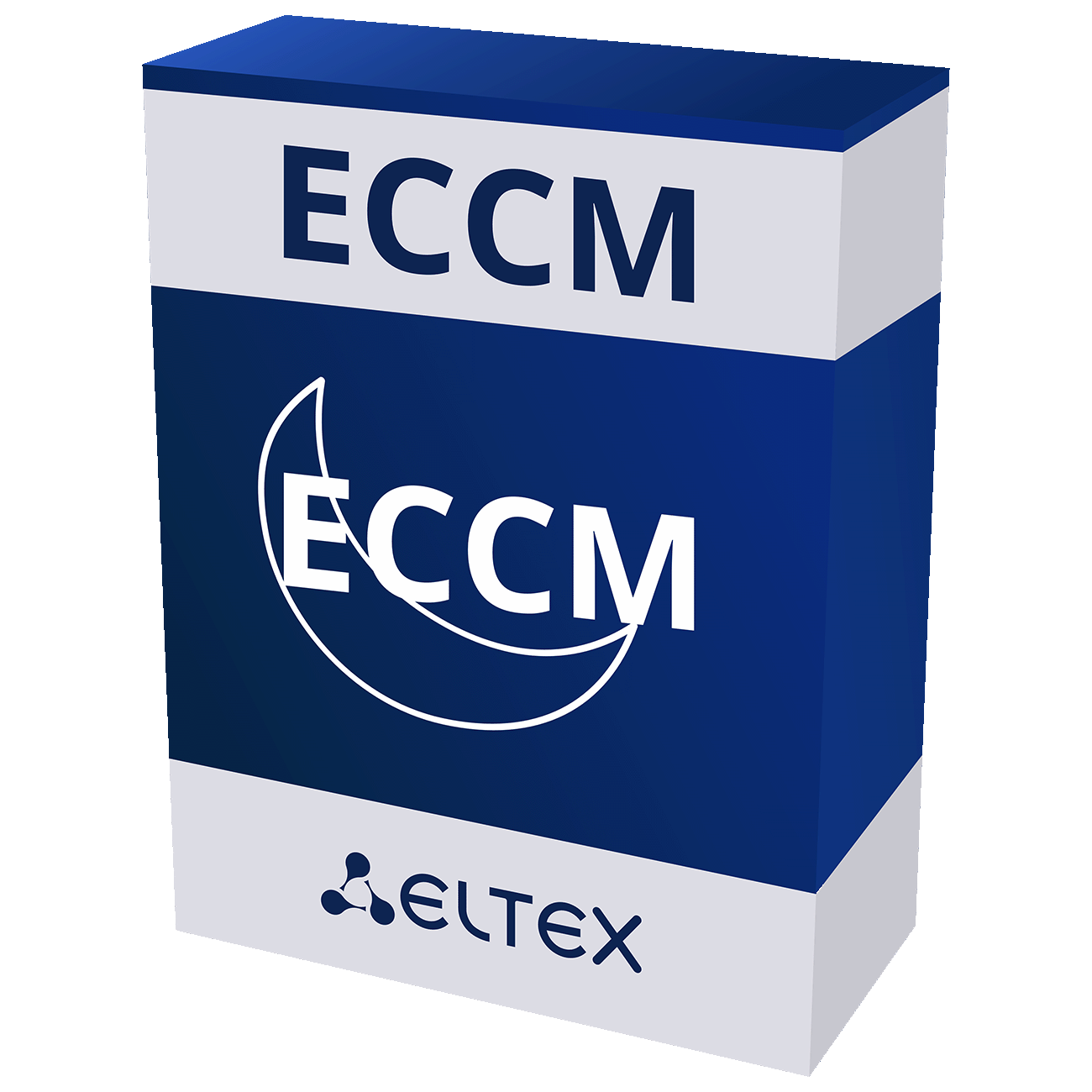
Related products






Documents and files
Firmware version 6.6.7.5
Added:
- Added information about the hardware version of the device to the output of the show system id command;
- The possibility of adding VLANs on LAG interfaces via the WEB has been implemented;
- Added support for LACP Force operation mode;
- Added the display of static multicast records in the ip igmp snooping table;
- Added support for collaboration between DHCP relay and DHCP server;
- Added the ability to disable the USB port;
- Added the ability to statically configure OSPF neighbors;
- Added OSPF network type non-broadcast, point-to-multipoint non-broadcast;
- Added VRF support in DHCP Relay;
- Added support for TCP adjust-mss;
- Added the possibility of extended IS-IS database output;
- The collaboration of DHCP Relay with EVPN/VXLAN is supported;
- Added Multi-VRF support for hardware BFD sessions;
- Added the ability for VPC peer detection to work in VRF;
- Added synchronization of ARP records between switches of the same EVPN multihoming ESI group.
Fixed:
- Fixed reboot when copying configuration via scp/tftp/flash;
- Optimized work with flash memory;
- Fixed a reboot when entering the show logging command in the stack;
- Fixed a bug that causes stack units to reboot when there is a high CPU load;
- Fixed a bug that caused the stack of MES3300-48 and MES3300-48F devices to fail;
- The do show ip interface vrf all command has been restored;
- Fixed the issue of LAG LACP recovery in timeout short mode;
- Fixed an erroneous change of the OSPF zone in the settings when executing the passive-interface command;
- Fixed mac address authorization in multi-sessions mode;
- Fixed an error when copying a configuration containing the switchport trunk allowed vlan all command;
- Fixed an error in displaying the role of neighbors in the output of the show ip ospf neighbor command;
- Fixed the problem of interrupting traffic processing on the master's CPU when there is a high load on the stack;
- Fixed a problem with VXLAN traffic transmission when using trunk ports between spine/leaf;
- Fixed a problem with traffic routing via L3VNI VXLAN when there is a default route;
- Fixed the error of removing standard ipv4/ipv6 ACLs from the configuration;
- Fixed the possibility of restarting the device at the time of removing the ACL from the VLAN interface with qos advanced-mode trust dscp configured;
- Fixed a problem with blocking traffic on slave units when configuring BPDU Guard in RPVST mode;
- Fixed an issue with an i2c bus failure in the stack;
- Fixed an issue with resetting the exp label in the mpls header in transit traffic;
- Fixed a bug with MAC Flapping in the VPC scheme when using the Po interface, number above 48;
- Fixed critical errors that occur when editing device configurations in a VPC pair;
- Fixed an error with rebooting the switch during SNMP requests for DDM information;
- Fixed an error with switching to local command authorization when there is no response from the tacacs server;
- Fixed an error with authorization of commands on the backup tacacs+ server when the main server is unavailable;
- Fixed an error with rebooting the switch when authenticating on the tacacs+ server in single-connection mode;
- Fixed an error indicating an incorrect port in the logs when receiving TC BPDU;
- Improved stability of the SSH server;
- Fixed the error of long Port-Channel transition to the Forwarding state when the portfast spanning-tree is configured on it;
- Improved VPC stability;
- Fixed incorrect operation of the BFD via the Port-Channel interface.
Previous versions
Firmware Version 6.6.5.4
Added:
- Ability to configure OOB interface as a source-interface for SNMPv2;
- Ability to configure OOB interface as a source-interface for SNMPv3;
- SNMPv2 support in VRF;
- SNMPv3 support in VRF;
- GRE tunnel support;
- Support for multihomed connections for EVPN/VxLAN scenario with Ingress Replication.
Fixed:
- Improved stability of peer-detection functionality in VPC;
- Erroneous removal of voice vlan from interface by timeout in the presence of port security settings;
- SSH session hangs due to an error in calculating Message authentication code in SSH packet.
Firmware Version 6.6.5
Added:
- Added support for BGP Route Map, Community List and AS-Path List in VRF;
- Added BFD support for BGP in VRF;
- Added BFD support for OSPF in VRF;
- Added support for encryption of the user's password using the SHA512/md5 algorithm;
- Added BFD support for IS-IS;
- Added the ability to change the ipv4 gateway address in EVPN type 5 routes;
- Added support for the RADIUS client in VRF;
- Added the ability to configure the source-interface OOB for SYSLOG;
- Added the ability to configure the OOB source-interface for TACACS+;
- Added BFD support for OSPF;
- Added support for VCT cable diagnostics for SFP-T;
- Added support for an extended number of UDBs in the ACL;
- Increased the number of ACEs in ACL to 512;
- Added support for filtering routes by the value of the as-path attribute in BGP;
- Added community support in BGP;
- Added the ability to configure the source-interface OOB for SNTP;
- Added support for SNTP operation in VRF;
- Added support for SYSLOG operation in VRF;
- Added support for the TACACS+ client in VRF;
- Added support for SSH server operation in VRF;
- Added ARP suppression support for EVPN/VXLAN.
Fixed:
- Fixed the process of removing the VRF setting from the OOB interface;
- Fixed the behavior in which STP root BPDU packets did not pass through the VPC peer-link;
- Fixed a reboot that occurred when the number of ACL rules with port-range was exceeded;
- Fixed L3VNI collaboration with VXLAN in multicast replication mode;
- Fixed incorrect operation of PBR with VRRP;
- Fixed device freeze when configuring SNMPv3;
- Fixed a behavior where a MAC-flapping storm started in a VPC;
- Fixed incorrect isolation of VPC groups from peer-link;
- Fixed a issue with OSPF neighbours breaking when CPU utilisation is high;
- Fixed issue with sending BGP update EVPN Type-2 when MAC address re-learning in a different ethernet-segment;
- Fixed issue with traffic switching via VRRP backup;
- Fixed problem with parasitic ICMP Redirect from VRRP backup when pinging a VRRP IP;
- Fixed a critical error occurring when CPU utilisation is high;
- Fixed critical error occurring when adding OUI for VOICE VLAN;
- Fixed critical error occurring when configuring sflow in stack;
- Fixed a critical error occurring when stack links are broken;
- Fixed critical errors occurring when building STP tree or VPC neighborhoods;
- Fixed L3VNI collaboration with VXLAN in multicast replication mode;
- Fixed PBR collaboration with VRRP;
- Fixed device freeze when removing ACL;
- Fixed device reboot related to the operation of the BGP protocol;
- Fixed device reboot when adding ACLs with UDP and TCP port ranges to the interface;
- Fixed device reboot when deleting VLAN bound to VXLAN;
- Fixed mac flapping between LAG when using VPC;
- Fixed incorrect addition of outgoing VRRPv2 protocol packets;
- Fixed a behavior in which STP root BPDU packets did not pass through the VPC peer-link.
Firmware Version 6.6.4
Added:
- The bit depth of the uptime counter has been increased;
- Added support for macro operation based on track status;
- Added support for cable diagnostics for MES2300-xx/MES3300-xx series devices;
- Added support for displaying information about QSFP28 in the output of the show inventory command;
- Added support for J9285D DAC cables;
- Added VRRP support to VRF;
- Added support for tftp in VRF;
- Added VRF support for the OOB interface;
- Added the ability to disable sending an empty packet to check the availability of the TFTP server;
- Added route-map support for OSPF;
- Added support for policy base routing next-hop;
- Added the ability to summarize routes in BGP;
- The value of the upper limit for the rate-limit has been increased;
- Added the ability to redistribute routes from eBGP to L3VPN;
- Added support for password encryption when logging commands;
- Added the possibility of simultaneous operation of MAC and IP access lists on interfaces;
- Added the ability to check the source mac address in the IP source-guard;
- Added the ability to limit the number of DHCP clients per port;
- Added the ability to send an snmp trap to the login/logout event.
Fixed:
- Software flow control is disabled for the console port;
- Fixed vulnerability of the Web interface;
- The position of the AAA command block in the configuration has been changed;
- Fixed the operation of the DHCP server when sending DHCP NAK packets;
- The operation of optical and copper switches in the same stack has been restored;
- Fixed an error that causes a cyclical reboot of a Slave unit in the stack when upgrading to version 6.6.3.8;
- Fixed rebooting of switches in the scheme with VxVLAN/EVPN when restarting the ospf process;
- Fixed single-hop BFD for eBGP neighborhoods;
- Fixed the problem of routing traffic between stack units for 2300/3300 devices;
- Fixed an error that caused the device to reboot when adding a non-existent VPC domain to the VPC group;
- Fixed an error that causes the role to be retransmitted after the Primary device is rebooted in the VPC;
- Fixed the problem of device freezing when flapping MLAG links in VPC;
- Fixed the problem of incorrect VPC assembly after restarting one of the paired devices;
- Fixed a cyclic reboot of the device when there is an ethertype switchport dot1q setting on the interface;
- Fixed an error in restoring the switchport default-vlan tagged command when updating software;
- Fixed an error where the L3 interface of the physical port did not switch to the Up state when rapid-pvst was enabled;
- Fixed the problem of blocking MLAG, after restarting it, in RPVST;
- Changed the default value of the spanning-tree cost parameter for 25G/40G/100G ports;
- Fixed spanning-tree cost calculation for port-channel interfaces;
- Fixed device reboot when polling the dot1dTpFdbEntry SNMP table;
- Fixed an error that occurs when deleting the SNMPv3 server settings from the configuration;
- Fixed an error when binding the ACL to the interface vlan.
Added:
- FEC operation support for 25G ports.
Fixed:
- Fixed switching part of the links to the UP status when using the FH-DP4T26QS05 40G QSFP/4 SFP+ Fang Zhang Copper Twinax Cable 5M cable.

